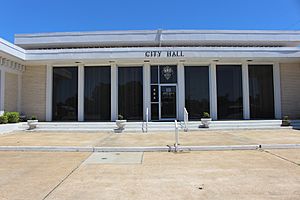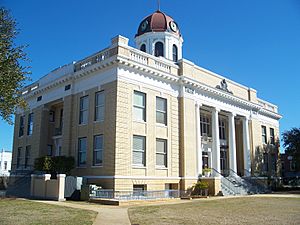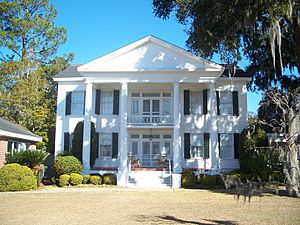Quincy, Florida facts for kids
Quick facts for kids
Quincy, Florida
|
|
|---|---|
| City of Quincy | |

Quincy City Hall
|
|
| Motto(s):
"...In the heart of Florida's future"
|
|

Location in Gadsden County and the state of Florida
|
|
| Country | United States of America |
| State | Florida |
| County | Gadsden |
| Incorporated | 1828 |
| Government | |
| • Type | Commission-Manager |
| Area | |
| • City | 11.65 sq mi (30.17 km2) |
| • Land | 11.65 sq mi (30.17 km2) |
| • Water | 0.00 sq mi (0.00 km2) |
| • Urban | 6.15 sq mi (15.93 km2) |
| Elevation | 207 ft (63 m) |
| Population
(2020)
|
|
| • City | 7,970 |
| • Density | 684.18/sq mi (264.16/km2) |
| • Urban | 8,541 |
| • Urban density | 1,387.80/sq mi (536.16/km2) |
| Time zone | UTC-5 (Eastern (EST)) |
| • Summer (DST) | UTC-4 (EDT) |
| ZIP codes |
32351-32353
|
| Area code(s) | 850 |
| FIPS code | 12-59325 |
| GNIS feature ID | 0289404 |
Quincy is a city in and the county seat of Gadsden County, Florida, United States. Quincy is part of the Tallahassee, Florida Metropolitan Statistical Area. The population was 7,970 as of the 2020 census, almost even from 7,972 at the 2010 census.
Contents
History
Established in 1828, Quincy is the county seat of Gadsden County, and was named for John Quincy Adams. It is located 25 miles (40 km) northwest of Tallahassee, the state capital. Quincy was once heavily dependent upon agriculture, farming tomatoes, tobacco, mushrooms, soybeans and other crops for its employment base.
Tobacco
In 1828, Governor William P. Duval introduced Cuban tobacco to the territory of Florida. As a result, the culture of shade-grown cigar wrapper tobacco was a dominant factor in the social and economic development of Gadsden County. Tobacco is a native plant of the western hemisphere. Early European explorers discovered Native Americans growing the plant when they set foot on their soil.
In 1829, John Smith migrated to Gadsden County in covered wagons with his family and four related families. Since there was already a resident named John Smith in the community, he became known as John "Virginia" Smith. When Smith ventured southward he brought with him a type of tobacco seed which was used for chewing and pipe smoking. He planted that seed and found that the plants grew vigorously. Because there was no market for tobacco in small quantities, it was twisted together, cured and shared with his friends. He purchased some Cuban tobacco seed and planted them with his Virginia tobacco. Several years passed and the two tobaccos blended.
When the Virginia tobacco was grown in Florida soil, it was much thinner and lighter in color. Smith began saving the seed from the hybridized stalks. From these seeds, a new plant known as "Florida Wrapper" was developed. So began a tobacco industry at a time when the South was suffering from the low price of cotton.
Growing tobacco continued to be profitable until the beginning of the Civil War in 1861, even when the European markets were no longer available. Of course, during the war and the Reconstruction Era, very little tobacco was grown except for personal use. Those days were tremendously difficult, and recovery was a slow process. The post-war search for a money crop led to the resurgence of the tobacco culture. Through these experiments it was discovered that tobacco which was light in color and silky in texture demanded the highest prices. So, with more experimentation, shading the plants began. At first, wood slats were used, but these proved too heavy. Then they tried slats draped with cheese cloth to keep the plants from the light. Next came ribbed cheese cloth. Ultimately in 1950, the white cheese cloth was replaced with a treated, longer lasting, yellow cloth that provided perfect shade.
Colonel Henry DuVal, president of the Florida Central and Peninsular Railroad, shipped samples of Gadsden County tobacco to New York for leaf dealers and cigar manufacturers to inspect. Soon representatives of several companies came down from New York to purchase land for growing tobacco. There was such an influx of land purchases that a number of packing houses arose. This continued until 1970 when tobacco companies came under fire and demand diminished. Around 1970, growing tobacco declined substantially in Gadsden. The development of a homogenized cigar wrapper, the ever-increasing cost of production, the subsidizing of the tobacco culture in Central America by the U.S. government, and the increasing, negative legal climate against the tobacco industry have added to the demise of Gadsden's future in tobacco. The last crop of shade-grown cigar wrapper tobacco was grown in 1977.
Quincy then turned to its other crops, tomato, mushroom and egg farms. This continued until the close of Quincy's mushroom factory and massive layoff of workers at Quincy's tomato farm in 2008. Quincy now turns to its businesses and is attempting to build itself into a business-based district.
Resistance to Jim Crow
During segregation Quincy residents responded to unrest by rioting. Some of the local businesses were burned and there were some acts of vandalism.
All American City
In 1996, Quincy was recognized as an All American City.
Essence article
In February 2003, an article in Essence magazine stated that Quincy was the city with the most AIDS cases in Florida. Some residents of the city were upset with the negative publicity. "Quincy has no more AIDS cases than typical rural cities in Florida", the mayor, Keith Dowdell, stated, and the city with the highest amount of AIDS cases in Florida in 2003 was Palm Beach, not Quincy. although the highest percentage of AIDS cases in Quincy at that time was in males.
Geography
Quincy is located in central Gadsden County at 30°35′N 84°35′W / 30.583°N 84.583°W (30.59, -84.58), in the rolling hills of North Florida.
U.S. Route 90 (Jefferson Street) is the main highway through the city; U-90 southeast 24 miles (39 km) to Tallahassee and northwest 19 miles (31 km) to Chattahoochee. The city limits extend south to beyond Interstate 10, which passes 3 miles (5 km) south of the center of the city. I-10 leads east 22 miles (35 km) to Tallahassee and west 170 miles (270 km) to Pensacola. Other highways in Quincy include SR 12, which leads 12 miles (19 km) to Havana and southwest 28 miles (45 km) to Bristol; SR 267, which leads north 8 miles (13 km) to the Georgia line and south 8 miles to Wetumpka; and SR 268, which leads southeast 11 miles (18 km) to Midway.
According to the United States Census Bureau, the city has a total area of 7.9 square miles (20.5 km2), of which 0.02 square miles (0.04 km2), or 0.18%, is water.
Climate
| Climate data for Quincy | |||||||||||||
|---|---|---|---|---|---|---|---|---|---|---|---|---|---|
| Month | Jan | Feb | Mar | Apr | May | Jun | Jul | Aug | Sep | Oct | Nov | Dec | Year |
| Mean daily maximum °F (°C) | 64 (18) |
67 (19) |
74 (23) |
79 (26) |
86 (30) |
90 (32) |
91 (33) |
90 (32) |
88 (31) |
81 (27) |
73 (23) |
66 (19) |
79 (26) |
| Mean daily minimum °F (°C) | 40 (4) |
42 (6) |
48 (9) |
52 (11) |
61 (16) |
68 (20) |
71 (22) |
70 (21) |
66 (19) |
57 (14) |
49 (9) |
42 (6) |
56 (13) |
| Average precipitation inches (mm) | 4.80 (122) |
4.92 (125) |
5.86 (149) |
3.68 (93) |
5.04 (128) |
5.92 (150) |
7.36 (187) |
6.78 (172) |
4.15 (105) |
4.11 (104) |
3.51 (89) |
3.77 (96) |
59.90 (1,521) |
| Source: Weatherbase | |||||||||||||
Demographics
| Historical population | |||
|---|---|---|---|
| Census | Pop. | %± | |
| 1870 | 743 | — | |
| 1880 | 639 | −14.0% | |
| 1890 | 681 | 6.6% | |
| 1900 | 847 | 24.4% | |
| 1910 | 3,204 | 278.3% | |
| 1920 | 3,118 | −2.7% | |
| 1930 | 3,788 | 21.5% | |
| 1940 | 3,888 | 2.6% | |
| 1950 | 6,505 | 67.3% | |
| 1960 | 8,874 | 36.4% | |
| 1970 | 8,334 | −6.1% | |
| 1980 | 8,591 | 3.1% | |
| 1990 | 7,444 | −13.4% | |
| 2000 | 6,982 | −6.2% | |
| 2010 | 7,972 | 14.2% | |
| 2020 | 7,970 | 0.0% | |
| U.S. Decennial Census | |||
2010 and 2020 census
| Race / Ethnicity (NH = Non-Hispanic) | Pop 2000 | Pop 2010 | Pop 2020 | % 2000 | % 2010 | % 2020 |
|---|---|---|---|---|---|---|
| White (NH) | 1,979 | 1,594 | 1,507 | 28.34% | 20.00% | 18.91% |
| Black or African American (NH) | 4,469 | 5,111 | 4,860 | 64.01% | 64.11% | 60.98% |
| Native American or Alaska Native (NH) | 10 | 24 | 5 | 0.14% | 0.30% | 0.06% |
| Asian (NH) | 16 | 52 | 34 | 0.23% | 0.65% | 0.43% |
| Pacific Islander or Native Hawaiian (NH) | 0 | 0 | 0 | 0.00% | 0.00% | 0.00% |
| Some other race (NH) | 0 | 17 | 19 | 0.00% | 0.21% | 0.24% |
| Two or more races or Multiracial (NH) | 27 | 66 | 123 | 0.39% | 0.83% | 1.54% |
| Hispanic or Latino (any race) | 481 | 1,108 | 1,422 | 6.89% | 13.90% | 17.84% |
| Total | 6,982 | 7,972 | 7,970 | 100.00% | 100.00% | 100.00% |
As of the 2020 United States census, there were 7,970 people, 2,642 households, and 1,728 families residing in the city.
By age, the population was split as such in 2020: 6.7% were under 5 years old, 27.8% were under 18 years old, and 13.8% were 65 years and older. 49.5% of the population were female. There were 370 veterans living in Quincy and 11.2% of the population were foreign born persons.
In 2020, the median value of owner-occupied housing units were $78,600. The median gross rent was $681. 76.3% of the households had a computer and 54.7% had a broadband internet subscription. 72.1% of the population 25 years and older were highschool graduates and 16.9% of that same population had a bachelor's degree or higher. The median household income was $31,756. The per capita income in a 12-month period was $17,117. 43.6% of the population lived below the poverty threshold.
As of the 2010 United States census, there were 7,972 people, 3,244 households, and 1,843 families residing in the city.
Arts and culture
Museums and other points of interest
Several locations in Quincy have been included in the National Register of Historic Places, most within the boundary of the Quincy Historic District. They are:
- E. B. Shelfer House
- E. C. Love House
- John Lee McFarlin House
- Judge P. W. White House
- Old Philadelphia Presbyterian Church
- Quincy Library
- Quincy Woman's Club
- Stockton-Curry House
- Willoughby Gregory House
The Gadsden Arts Center, an AAM accredited art museum housed in the renovated 1912 Bell & Bates hardware store, with rotating regional & national art exhibitions and a permanent collection of Vernacular Art, is also situated in the Quincy Historic District.
Also notable is the Leaf Theater, which is considered a "historic cinema treasure." It is also said to be haunted.
The North Florida Research and Education center is on Pat Thomas Parkway in Quincy.
The Florida A&M Research and Extension Center is located on Old Bainbridge Road in the St. John community of Quincy.
Media
Quincy has two local papers that cover all of Gadsden County, The Gadsden County Times of Gadsden County and The Herald of the city of Havana, Florida.
Education
The Gadsden County School District operates area public schools.
- Carter-Parramore Academy School
- Chattahoochee Elementary School
- Crossroad Academy Charter School
- Gadsden Central Academy School
- Gadsden County High School
- Gadsden Elementary Magnet School
- Gadsden Technical Institute School
- George W. Munroe Elementary School
- Greensboro Elementary School
- Havana Magnet School
- James A. Shanks Middle School
- Stewart Street Elementary School
- West Gadsden Middle School
In 2003, James A. Shanks High School in Quincy and Havana Northside High School consolidated into East Gadsden High School. In 2017, East Gadsden High became the only zoned high school in the county due to the consolidation of the high school section of West Gadsden High School into East Gadsden.
Robert F. Munroe Day School, a K–12 private school which was founded as a segregation academy, has its kindergarten campus, the Robert F. Munroe Day Kindergarten, in Quincy proper. The main campus for grade 1–12 in nearby Mount Pleasant.
The Gadsden County Public Library system operates the William A. "Bill" McGill Public Library.
Transportation
Highways
U.S. Route 90 (Jefferson Street) is the main highway through the city; US 90 leads southeast 24 miles (39 km) to Tallahassee and northwest 19 miles (31 km) to Chattahoochee. The city limits extend south to beyond Interstate 10, which passes 3 miles (5 km) south of the center of the city. I-10 leads east 22 miles (35 km) to Tallahassee and west 170 miles (270 km) to Pensacola.
Other highways in Quincy include SR 12, which leads 12 miles (19 km) to Havana and southwest 28 miles (45 km) to Bristol; SR 267, which leads north 8 miles (13 km) to the Georgia line and south 8 miles to Wetumpka; and SR 268, which leads southeast 11 miles (18 km) to Midway.
Transit
Shuttle-bus and van transportation between Quincy and Chattahoochee, Havana, and Tallahassee is provided by Big Bend Transit, which operates three routes serving the area.
Railroad
Freight service is provided by the Florida Gulf & Atlantic Railroad, which acquired most of the former CSX main line from Pensacola to Jacksonville on June 1, 2019.
Airport
Quincy Municipal Airport is a public-use airport located 2 miles (3.2 km) northeast of the central business district.
Coca-Cola
Quincy investors were largely responsible for the development of its local Coca-Cola company into a worldwide conglomerate. Quincy was once rumored to be home to many millionaires due to the Coca-Cola boom. Mark Welch “Mr Pat” Munroe, a local banker, father of 18 children by two wives, and W.C. Bradley were among the stockholders of three of the banks that released 500,000 shares of new Coca-Cola common stock. They urged widows and farmers to invest for $40 each, and several did. Eventually that stock split, and made as many as 67 accounted-for investors and Gadsden County residents rich. A single share of Coca-Cola stock bought in 1919 for $40 would be worth $6.4 million today, if all dividends had been reinvested.
Notable people
- Nat Adderley Jr. (born 1955), music arranger who spent much of his career with Luther Vandross
- Elizabeth Whitfield Croom Bellamy (1837–1900), writer
- The Lady Chablis (1957–2016), born Benjamin Edward Knox, transgender entertainer best known for her appearance in the book and subsequent movie adaptation of Midnight in the Garden of Good and Evil
- Billy Dean (born 1962), country music singer
- Freddie Figgers (born 1989), electronics inventor and entrepreneur
- Mack Lee Hill (1940–1965), football player and American Football League All-Pro RB for the Kansas City Chiefs
- Willy Holt (1921–2007), French-American film production designer and art director
- Dexter Jackson (born 1977), football player and Super Bowl XXXVII MVP
- Nathan Kellogg McGill, attorney who represented The Chicago Defender and served on the Chicago Library board in Chicago, Illinois
- Jerrie Mock (1925–2014), first woman to fly solo around the world
- TeJyrica Robinson (born 1998), American hurdler
- Willie Simmons (born 1980), head coach of the Florida A&M Rattlers football team
Gallery
See also
 In Spanish: Quincy (Florida) para niños
In Spanish: Quincy (Florida) para niños
















